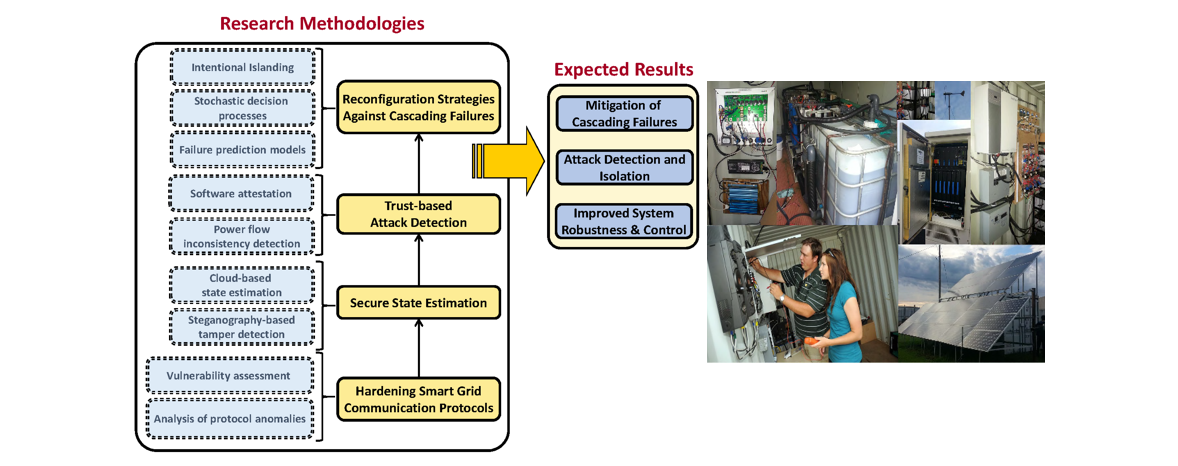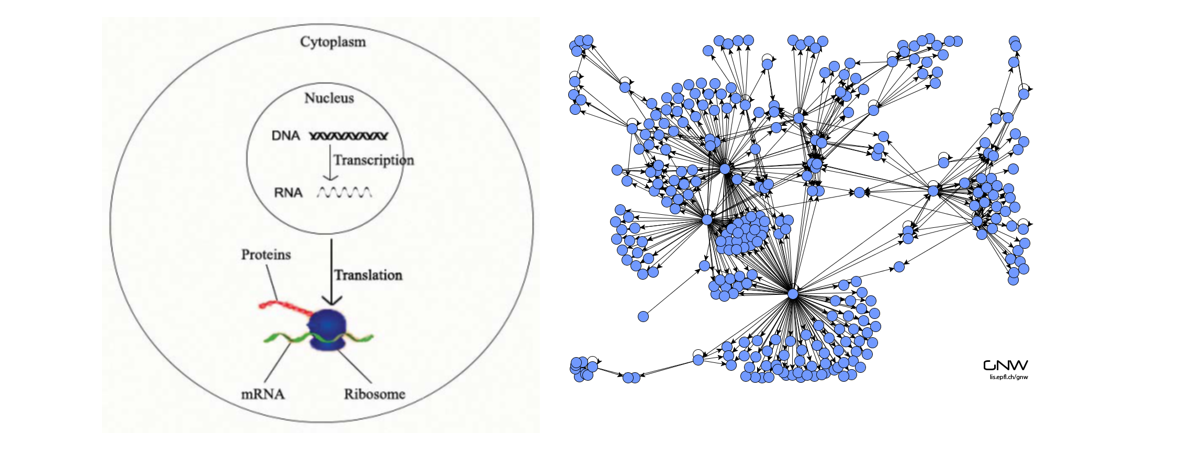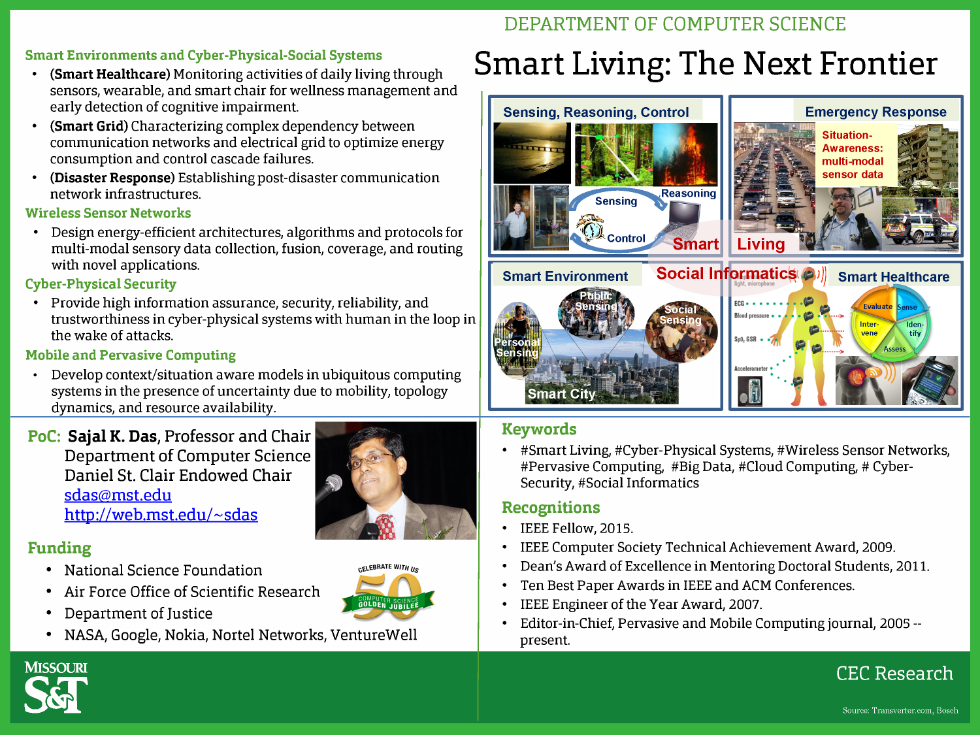Sajal Das
Daniel St. Clair Endowed Chair Professor
Computer Science
- sdas@mst.edu
- Phone: (573) 341-7708
- 325 Computer Science Building
Publications:
- Crafting a Human-Centric Environment to Support Human Health Needs
- Securing Smart Grid by Understanding Communications Infrastructure Dependencies
- BISON: Bio-Inspired Approach to Robust Wireless Sensor Networking
- SPANDAN: Scalable Parallel Algorithms for Network Dynamics Analysis
- THREAT ASSESSMENT TOOLS FOR MANAGEMENT-COUPLED CYBER- AND PHYSICAL
Crafting a Human-Centric Environment to Support Human Health Needs
Crafting a Human-Centric Environment to Support Human Health Needs
INVESTIGATORS
Sajal K. Das (sdas@mst.edu, 573-341-7708)
FUNDING SOURCE
National Science Foundation (Smart and Connected Health Program)
PROJECT DESCRIPTION
The goal of this project is to design, implement, and evaluate in-home techniques for generating reports of activities and social interactions that are useful for monitoring well-being and for automating intervention strategies for persons with dementia. The plan is to design machine learning techniques that make effective use of sensor data to perform automated activity monitoring and prompting-based interventions that are beneficial for the residents as well as for their caregivers and family. The environment is human-centric because it learns information about its human residents and uses this information to provide activity-aware monitoring and intervention services. By transforming everyday environments into smart environments, many older adults with cognitive and physical impairment can lead independent lives in their own homes. A key component of this project is an evaluation of the technologies in actual homes with volunteer older adults and thus will assess the technologies for acceptance with the target population.
PUBLICATIONS
- “Quality and Context-Aware Smart Healthcare,” N. Roy, C. Julien, A. Misra, and S. K. Das, IEEE Systems, Man and Cybernetics Magazine, 2(2): 15-25 (2016).
- “Determining Quality- and Energy-Aware Multiple Contexts in Pervasive Computing Environments,” N. Roy, A. Misra, S. K. Das, and C. Julien, IEEE/ACM Transactions on Networking, 24(5): 3026-3042 (2016).
- “Incentive Mechanisms for Participatory Sensing: Survey and Research Challenges” F. Restuccia, S. K. Das, and J. Payton, ACM Transactions on Sensor Networks, 12(2): 2016.
- “Multi-modal Wearable Sensing for Fine-grained Activity Recognition in Healthcare,” D. De, P. Bharti, S. K. Das, and S. Chellappan, IEEE Internet Computing (special issue on Small Wearable Internet), 19(5): 26-35 (2015).
- “A-Wristocracy: Deep Learning on Wrist-worn Sensing for Recognition of User Complex Activities”, P. Vepakommaz, D. De, S. K. Das, and S. Bhansal, Proceedings of 12th IEEE Annual Body Sensor Networks Conference (BSN). MIT, Cambridge (2015).
- “Care-Chair: Sedentary Activities and Health Assessment with Smart Sensing on Chair Backrest,” R. Kumar, A. Bayliff, D. De, A. Evans, S. K. Das, and M. Makos, Proceedings of 2nd IEEE International Conference on Smart Computing (2016).
- “An Adaptive Bayesian System for Context-Aware Data Fusion in Smart Environments,” A. De Paola, P. Ferraro, S. Gaglio, G. Lo Re and S. K. Das, IEEE Transactions on Mobile Computing, 16(6): 1505-1512,2017.
- F. Gu, J. Niu, S. K. Das, and Z. He, “RunnerPal: A Runner Monitoring and Advisory System Based on Smart Devices,” IEEE Transactions on Service Computing (Special Issue on Mobile and Cloud Services for Digital Health), to appear 2017.
- F. Gu, J. Niu, S. K. Das, Z. He, and X. Jin, “Detecting Breathing Frequency and Maintaining a Proper Running Rhythm, Pervasive and Mobile Computing, to appear, 2017.
- S. Khalifa, M. Hassan, S. K. Das, and A. Seneviratne, “Energy Harvesting Wearables for Activity-aware Services,” IEEE Internet Computing (special issue on Small Wearable Internet), 19(5): 8-16, Oct 2015.
Securing Smart Grid by Understanding Communications Infrastructure Dependencies
Securing Smart Grid by Understanding Communications Infrastructure Dependencies

INVESTIGATORS
Sajal K. Das (sdas@mst.edu, 573-341-7708), Mariesa Crow and Simone Silvestri
FUNDING SOURCE
National Science Foundation (Cyber-Physical Systems Program)
PROJECT DESCRIPTION
The objective of this collaborative project is to understand, study and analyze in a holistic manner the vulnerabilities of smart grid system due to intricate interactions with the communication networks. Specific goas include: (i) investigating a wide variety of attacks, misconfiguration, malfunctioning, and failure scenarios in the communications networks, and characterizing their impacts on the smart grid; and (ii) designing a multi-level security framework based on robust state estimation and trust model that hardens the grid against malfunctions and attacks from the communications side, thus preventing cascade failures.
PUBLICATIONS
- “Managing Contingencies in Smart Grids via the Internet of Things,” S. Ciavarella, J.-Y. Joo, and S. Silvestri, IEEE Transactions on Smart Grid, 7(4): 2134-2141 (2016).
- “Survey of Security Advances in Smart Grid: A Data Driven Approach,” S. Tan, D. De, W.-Z. Song, J. Yang, and S. K. Das, IEEE Communications Surveys and Tutorials, 18(1): 397-422, Jan-Feb 2017.
- “Towards a Realistic Model for Failure Propagation in Interdependent Networks,” A. Sturaro, S. Silvestri, M. Conti, and S. K. Das, Proceedings of International Conference on Computing, Networking and Communications, Hawaii (2016).
- “Reliable Energy-Efficient Uplink Transmission for Neighborhood Area Networks in Smart Grid,” F. Ye, Y. Qian, R. Q. Hu, and S. K. Das, IEEE Transactions on Smart Grid (special issue on Cyber Physical Systems and Security for Smart Grid), 6(5): 2179-2188 (2015).
- “JAMMY: A Distributed and Self-Adaptive Solution against Selective Jamming Attack in TDMA WSNs,” M. Tiloca, D. De Guglielmo, G. Dini, G. Anastasi, and S. K. Das, IEEE Transactions on Dependable and Secure Computing, 14(4): 392-405, July-Aug 2017.
- “Incentive Mechanism Design for Heterogeneous Crowdsourcing Using All-Pay Contests,” T. Luo, S. S. Kanhere, S. K. Das, and H.-P. Tan, IEEE Transactions on Mobile Computing, 15(9): 2234-2246 (2016).
- “An Efficient Security Protocol for Advanced Metering Infrastructure in Smart Grid,” Y. Yan, R. Q. Hu, S. K. Das, H. Sharif, and Y. Qian, IEEE Network, 27(4): 1-10 (2013).
- S. Bhattacharjee, A. Thakur, S. Silvestri, and S. K. Das, “Statistical Security Incident Forensics against Data Falsification in Smart Grid Advanced Metering Infrastructure,” Proceedings of 7th ACM Conference on Data and Applications Security and Privacy (CODASPY), Scottsdale, Arizona, pp. 35-45, Mar 2017.
BISON: Bio-Inspired Approach to Robust Wireless Sensor Networking
BISON: Bio-Inspired Approach to Robust Wireless Sensor Networking

INVESTIGATORS
Sajal K. Das (sdas@mst.edu, 573-341-7708)
FUNDING SOURCE
National Science Foundation
PROJECT DESCRIPTION
Organisms adapt to external perturbations through optimized structure of their gene regulatory networks (GRNs). In the long-term, the state transition network of a GRN converges to a set of attractors that make the organism resilient to removal or functional impairment of genes. In wireless sensor networks (WSNs), such attractors refer to a group of sensors serving as sink nodes for packets sent over multiple hops. This project maps such attractor based genomic robustness onto WSNs to infer optimal topologies and routing strategies that mitigate both sensor failure and a noisy wireless channel. This is being achieved by conducting experiments in silico gene by simulating the functional removal of a gene from sample GRNs, to understand the dynamics of the attractor state space. This information is next used to design WSN topologies and routing protocols that are resilient to network uncertainty, node breakdown and compromise. This project also pursues the design of optimal wiring rules between sensors in a robust WSN that guarantees maximum probability of successful packet transmission under a given routing strategy. Validation and testing are accomplished on real life WSN testbeds.
PUBLICATIONS
- “DRIH-MAC: A Distributed Receiver-Initiated Harvesting-aware MAC for Nano-Networks,” S. Mohrehkesh, M. Weigle, S. K. Das, IEEE Transactions on Molecular, Biological and Multi-Scale Communications, 1(1): 97-110 (2015).
- “Energy-efficient Randomized Switching for Maximizing Lifetime in Tree-based Wireless Sensor Networks,” Sk. K. A. Imon, A. Khan, M. Di Francesco, and S. K Das, IEEE/ACM Transactions on Networking, 23(5): 1401-1415 (2015).
- “Exploiting gene regulatory networks for robust wireless sensor networking,” M. Nazi, M. Raj, Di Francesco, P. Ghosh, and S. K. Das. In Proceedings of IEEE Global Communications Conference (GlobeCom): Selected Areas in Communications: Molecular, Biological and Multi-Scale Communications), San Diego (2015).
- “Leveraging the Robustness of Genetic Networks: A Case Study on Bio-inspired Wireless Sensor Network Topologies,” B. K Kamapantula, A. Abdelzaher, P. Ghosh, M. Mayo, E. J Perkins, and S. K Das, Journal of Ambient Intelligence and Humanized Computing, 5(3):323–339 (2014).
- “Deployment of Robust Wireless Sensor Networks using Gene Regulatory Networks: An Isomorphism-based Approach,” A. Nazi, M. Raj, M. Di Francesco, P. Ghosh, and S. K Das, Pervasive and Mobile Computing, 13:246–257 (2014).
- “Qos-aware Geographic Opportunistic Routing in Wireless Sensor Networks,” L. Cheng, J. Niu, J. Cao, S. K Das, and Y. Gu, IEEE Transactions on Parallel and Distributed Systems, 25(7):1864–1875 (2014).
- “Analysis and Optimization of a Protocol for Mobile Element Discovery in Sensor Networks,” F. Restuccia, G. Anastasi, M. Conti, and S. K Das, IEEE Transactions on Mobile Computing, 13(9):1942–1954 (2014).
- S. Mohrekesh, M. C. Wiegle, and S. K. Das, “Energy Harvesting in Electromagnetic Nanonetworks,” IEEE Computer, 50(2), 59-67, Feb 2017.
- S. Roy, M. Raj, P. Ghosh, and S. K. Das, “Role of Motifs in Topological Robustness of Gene Regulatory Networks,” Proceedings of IEEE International Conference on Communications (ICC), in SAC Symposium Molecular, Biological, and Multi-Scale Communications Track, Paris, France, May 21-25, 2017.
- S. Roy, V. Shah, and S. K. Das, “Characterization of E. Coli Gene Regulatory Network and its Topological Enhancement by Edge Rewiring,” Proceedings of 9th International Conference on Bio-inspired Information and Communications Technologies (BICT), New York City, Dec 2015.
SPANDAN: Scalable Parallel Algorithms for Network Dynamics Analysis
SPANDAN: Scalable Parallel Algorithms for Network Dynamics Analysis

INVESTIGATORS
Sajal K. Das (sdas@mst.edu, 573-341-7708)
FUNDING SOURCE
National Science Foundation
PROJECT DESCRIPTION
The goal of this project is to create a novel architecture-independent framework for designing efficient, portable and scalable parallel algorithms for analyzing large-scale dynamic networks, such as social networks, biological networks, and disaster networks. The basic idea is to exploit graph sparsification techniques to divide the network into sparse subgraphs (certificates) that form the leaves of a sparsification tree. This innovative approach leads to the design and analysis of efficient parallel algorithms for updating dynamic networks, and reduction of memory latency associated with parallelizing unstructured data. Specifically, parallel algorithms will be designed for maintaining network topological characteristics and updating influential vertices and communities. The portability and performance of algorithms will be demonstrated via implementation on distributed memory clusters, shared memory multicores, and massively multithreaded parallel computers.
PUBLICATIONS
- “PIS: A Multi-dimensional Routing Protocol for Socially-aware Networking,” F. Xia, L. Liu, B. Jedari, and S. K. Das, IEEE Transactions on Mobile Computing, 15(9): 2234-2246, Sept 2016.
- “Overhead Control with Reliable Transmission of Popular Packets in Ad-Hoc Social Networks,” F. Xia, H. B. Liaqat, J. Deng, J. Wan, and S. K. Das, IEEE Transactions on Vehicular Technology, 65(9): 7647-7661 (2016).
- “Application of Graph Sparsification in Developing Parallel Algorithms for Updating Dynamic Networks,” S. Srinivasan, S. K. Das and S. Bhowmick, Graph Algorithm Building Blocks Workshop at IEEE International Symposium on Parallel and Distributed Processing Systems, Chicago (2016).
- “Leveraging Contact Pattern to Predict Future Contact Pattern in Mobile Networks,” S. Das, S. K. Das, and S. Ghosh, Proceedings of 8th International Workshop on Hot Topics in Planet-scale mobile computing and online Social Networking (HotPOST’16), Paderborn, Germany (2016).
- “RescuePal: a Smartphone-based System to Discover People in Emergency Scenarios,” F. Restuccia, S. K. Das, S. C. Thandu, and S. Chellappan, Proceedings of 5th Workshop on Internet of Things: Smart Objects and Systems (IoT-SoS), Coimbra, Portugal (2016).
- “Interference-free Scheduling with Minimum Latency in Cluster-based Wireless Sensor Networks,” A. Navarra, C. M. Pinotti, M. Di Francesco, and S. K. Das, Wireless Networks, 21(7): 2395-2411 (2015).
- “Leveraging Network Structure in Centrality Evaluation of Large Scale Networks,” S. Das and S. K. Das, Proceedings of 40th Annual IEEE Conference on Local Computer Networks (LCN), Clearwater Beach, FL, pp. 579-586, Oct 2015.
- “E-DARWIN: Energy Aware Disaster Recovery Network using WiFi Tethering,” M. Raj, K. Kant, and S. K. Das, Proceedings 23rd International Conference on Computer Communications and Networks, Shanghai, China, pp. 1-8 (2014).
- “Updating Dynamic Networks in Parallel Using Graph Sparsification,” S. Srinivasan, S. K. Das and S. Bhowmick, Minisymposium on HHigh-PerformanceGraph Algorithms at SIAM CSE 2017.
- V. Shah, S. Roy, S. Silvestri, and S. K. Das, “CTR: Cluster based Topological Routing for Disaster Response Networks,” Proceedings of IEEE International Conference on Communications (ICC), in Ad-Hoc and Sensor Networking Symposium (AHSN), Paris, France, May 21-25, 2017.
- “Multi-Periodic Contact Patterns in Predicting Future Contacts Over Mobile Networks,” S. Das and S. K. Das, Proceedings of IEEE Symposium on a World of Wireless Mobile Multimedia Networks, Macau, China, June 2017.
- “Graph Compaction in Analyzing Large Scale Online Social Networks,” S. Das, J. Leopold, S. Ghosh, and S. K. Das, Proceedings of IEEE International Conference on Communications (ICC), in SAC Symposium Social Networking Symposium Track (SAC-SN), Paris, France, May 21-25, 2017.
- “A Probabilistic Link Prediction Model in Time-Varying Social Networks,” S. Das and S. K. Das, Proceedings of IEEE International Conference on Communications (ICC), in SAC Symposium Social Networking Symposium Track (SAC-SN), Paris, France, May 21-25, 2017.
- “Inferring Future Links in Large Scale Networks,” S. Das, S. K. Das, and S. Ghosh, Proceedings of 41st Annual IEEE Conference on Local Computer Networks (LCN), Dubai, UAE, pp. 244-252, 2016.
- “Graph Partitioning in Parallelization of Large Scale Networks,” S. Das, J. Leopold, S. Ghosh, and S. K. Das, Proceedings of 41st Annual IEEE Conference on Local Computer Networks (LCN), Dubai, UAE, Nov 2016.
- “Leveraging Contact Pattern to Predict Future Contact Pattern in Mobile Networks,” S. Das, S. K. Das, and S. Ghosh, Proceedings of 8th International Workshop on Hot Topics in Planet-scale mObile computing and online Social neTworking (HotPOST’16), Paderborn, Germany, July 2016.
THREAT ASSESSMENT TOOLS FOR MANAGEMENT-COUPLED CYBER- AND PHYSICAL
Threat Assessment Tools for Management-Coupled Cyber- and Physical- Infrastructures
INVESTIGATORS
Sajal K. Das (sdas@mst.edu, 573-341-7708)
FUNDING SOURCE
National Science Foundation (Cyber-Physical Systems Program)
PROJECT DESCRIPTION
The objective of this multi-university collaborative project is to develop an innovative modeling framework and tool suite for assessing complex threats from natural and sentient adversaries in the management-coupled cyber- and physical- infrastructures (MCCPIs) with a human in the loop. Specific goals include: 1) modeling the hybrid, stochastic, and multi-layer dynamics of MCCPIs; 2) characterizing different types of adversaries and develop trust models to deal with data falsification; and 3) building effective strategies for threat and vulnerability assessment and subsequent mitigation. The developed tool suite will be applied to air transportation system with a goal to provide situational awareness of the propagative impacts of threats across networked physical-, cyber-, and human elements.
Light Weight, Real Time Anomaly Detection Scheme
PUBLICATIONS
- [M. Tiloca, D. De Guglielmo, G. Dini, G. Anastasi, and S. K. Das, “JAMMY: A Distributed and Self-Adaptive Solution against Selective Jamming Attack in TDMA WSNs,” IEEE Transactions on Dependable and Secure Computing, 14(4): 392-405, July-Aug 2017.
- N. Marchang R. Dutta, and S. K. Das, “A Novel Approach for Efficient Usage of Intrusion Detection System in Mobile Ad Hoc Networks,” IEEE Transactions on Vehicular Technology, 66(2): 1684-1695, Feb 2017.
- S. Saha, S. Nandi, R. Verma, S. Sengupta, K. Sing, V. Sinha, and S. K. Das, “Design of Efficient Lightweight Strategies to Combat DoS Attack in Delay Tolerant Network Routing,” Wireless Networks, to appear, 2017.
- C.-L. Wang, F. Ma, J. Yan, D. De, and S. K. Das, “Efficient Aerial Data Collection with UAV in Large-scale Wireless Sensor Networks,” International Journal of Distributed Sensor Networks, to appear, 2017.
- S. Bhattacharjee, A. Thakur, S. Silvestri, and S. K. Das, “Statistical Security Incident Forensics against Data Falsification in Smart Grid Advanced Metering Infrastructure,” Proceedings of 7th ACM Conference on Data and Applications Security and Privacy (CODASPY), Scottsdale, AZ, pp. 35-45, Mar 2017.
- S. Bhattacharjee, N. Ghosh, V. K. Shah, and S. K. Das, “QnQ: A Reputation Model to Secure Mobile Crowdsourcing Applications from Incentive Losses,” Proceedings of the IEEE Conference on Communications and Network Security (CNS), Las Vegas, NV, Oct 9-11, 2017.
- T. Luo, S. S. Kanhere, J. Huang, S. K. Das, and F. Wu, “Sustainable Incentives for Mobile Crowdsensing: Auctions, Lotteries, Trust and Reputation Systems,” IEEE Communications Magazine (special issue on Sustainable Incentive Mechanisms for Mobile Crowdsensing), 55(3): 68-74, Mar 2017.
- T. Luo, S. K. Das, H.-P. Tan, and L. Xia, “Incentive Mechanism Design for Crowdsourcing: An All-Pay Auction Approach,” ACM Transactions on Intelligent Systems and Technology, 7(3): 1-26, 2016.




Follow Intelligent Systems Center